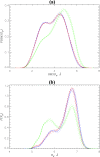Binding of Inhibitors to Nuclear Localization Signal Peptide from Venezuelan Equine Encephalitis Virus Capsid Protein Explored with All-Atom Replica Exchange Molecular Dynamics
- PMID: 39346821
- PMCID: PMC11425950
- DOI: 10.1021/acsomega.4c06981
Binding of Inhibitors to Nuclear Localization Signal Peptide from Venezuelan Equine Encephalitis Virus Capsid Protein Explored with All-Atom Replica Exchange Molecular Dynamics
Abstract
Several small molecule inhibitors have been designed to block binding of the Venezuelan equine encephalitis virus (VEEV) nuclear localization signal (NLS) sequence to the importin-α nuclear transport protein. To probe the inhibition mechanism on a molecular level, we used all-atom explicit water replica exchange molecular dynamics to study the binding of two inhibitors, I1 and I2, to the coreNLS peptide, representing the core fragment of the VEEV NLS sequence. Our objective was to evaluate the possibility of masking wherein binding of these inhibitors to the coreNLS occurs prior to its binding to importin-α. We found that the free energy of I1 and I2 binding to the coreNLS is less favorable than that to importin-α. This outcome argues against preemptive inhibitor binding to the coreNLS prior to importin-α. Instead, both inhibitors are expected to compete with the coreNLS peptide for binding to importin-α. The two factors responsible for the low affinities of the inhibitors to the coreNLS peptide are (i) the low cooperativity of binding to the peptide and (ii) the strong hydrophobic effect associated with binding to importin-α. Our results further show that upon binding to the coreNLS peptide, the inhibitors form multiple diverse binding poses. The coreNLS peptide coincubated with I1 and I2 adopts several conformational states, including open and collapsed, which underscores the fluidity of the coreNLS conformational ensemble as a target for inhibitors. Taken together with our prior investigations, this study sheds light on the molecular mechanism by which I1 and I2 ligands inhibit binding of the VEEV capsid protein to importin-α.
© 2024 The Authors. Published by American Chemical Society.
Conflict of interest statement
The authors declare no competing financial interest.
Figures




Similar articles
-
Competitive Binding of Viral Nuclear Localization Signal Peptide and Inhibitor Ligands to Importin-α Nuclear Transport Protein.J Chem Inf Model. 2024 Jul 8;64(13):5262-5272. doi: 10.1021/acs.jcim.4c00626. Epub 2024 Jun 13. J Chem Inf Model. 2024. PMID: 38869471 Free PMC article.
-
Binding of viral nuclear localization signal peptides to importin-α nuclear transport protein.Biophys J. 2023 Sep 5;122(17):3476-3488. doi: 10.1016/j.bpj.2023.07.024. Epub 2023 Aug 4. Biophys J. 2023. PMID: 37542371 Free PMC article.
-
Binding of Venezuelan Equine Encephalitis Virus Inhibitors to Importin-α Receptors Explored with All-Atom Replica Exchange Molecular Dynamics.J Phys Chem B. 2023 Apr 13;127(14):3175-3186. doi: 10.1021/acs.jpcb.3c00429. Epub 2023 Mar 31. J Phys Chem B. 2023. PMID: 37001021 Free PMC article.
-
Venezuelan Equine Encephalitis Virus Capsid-The Clever Caper.Viruses. 2017 Sep 29;9(10):279. doi: 10.3390/v9100279. Viruses. 2017. PMID: 28961161 Free PMC article. Review.
-
Nucleocytoplasmic protein transport and recycling of Ran.Cell Struct Funct. 1999 Dec;24(6):425-33. doi: 10.1247/csf.24.425. Cell Struct Funct. 1999. PMID: 10698256 Review.
References
LinkOut - more resources
Full Text Sources
